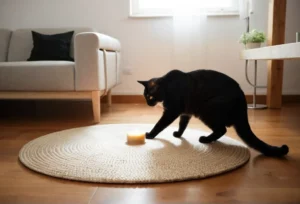Cats are known for their quirky behaviors, one of which is their tendency to engage in a digging motion. Have you ever wondered why cats do this strange behavior? Today, we’re going to explore the reasons behind this fascinating feline habit.
Cats Digging Motion: An Insightful Look
Instinctual Behavior
Have you ever noticed your cat performing a digging motion with their paws? This behavior is actually a natural instinct that all cats possess. Digging is a behavior that stems from their wild ancestors who would dig in the ground to bury their waste or hide their food. This instinctual behavior is deeply ingrained in cats and can be seen even in domesticated felines. By digging, cats are tapping into their innate instincts and fulfilling a primal need to dig and bury.
Cats may also exhibit digging behavior as a way to mark their territory. By digging in a particular spot, they are leaving behind their scent, claiming that area as their own. This behavior is a form of communication, signaling to other animals that this territory belongs to them. So, the next time you see your cat digging in the litter box or scratching at the furniture, remember that they are simply following their natural instincts.
Communication Through Digging
In addition to instinctual behavior, digging can also serve as a form of communication for cats. When a cat digs at their bedding or scratches at the floor, they may be trying to send a message to their owners or other animals. This digging motion could be a way for cats to indicate that they are feeling anxious, frustrated, or in need of attention.
Furthermore, digging can also be a sign of affection from your cat. When they dig at your lap or snuggle in and dig their paws into your skin, they are showing you that they trust and love you. It’s their way of bonding and expressing their feelings towards you. So, next time your cat starts digging around, pay attention to the context and see if they are trying to communicate with you in their own feline way.
Remember, understanding your cat’s digging behavior can help strengthen the bond between you and your feline friend. By recognizing the instinctual and communicative aspects of digging, you can better respond to your cat’s needs and provide them with the love and care they deserve.
Marking Territory
Have you ever noticed your cat engaging in that rhythmic digging motion, almost as if they’re trying to unearth buried treasure? Well, that behavior actually serves a purpose beyond just rearranging your carpet. Cats use this digging motion as a way to mark their territory. By scratching and digging, they leave behind both visual and scent markers, signaling to other animals that this area belongs to them. This territorial behavior helps cats establish boundaries in their environment and communicate with other felines in the area. So, the next time you catch your cat digging away, know that they’re just claiming their kingdom!
Hunting Instincts
In addition to marking their territory, a cat’s digging behavior is deeply rooted in their natural hunting instincts. When a cat digs in the wild, they are not only sharpening their claws but also practicing the movements necessary for catching prey. This digging motion mimics the action of covering and uncovering food or prey, a behavior that dates back to their days as wild hunters. So, when your domestic cat displays this digging behavior, they are simply following their innate instincts to hunt and capture prey, even if their “prey” is just a toy or a piece of kibble.
Additional Unique Insight:
While domestic cats may not rely on hunting for survival like their wild counterparts, their digging behavior remains a vestige of their ancestral instincts. By providing opportunities for interactive play that mimic hunting behaviors, such as using toys that encourage pouncing and digging, you can help satisfy your cat’s natural instincts and provide mental stimulation.
Comfort and Security
Cats often do a digging motion to create a comfortable and secure sleeping area. In the wild, they would dig to make a cozy spot to rest and hide from predators. By exhibiting this behavior at home, they mimic their natural instincts and feel safe and secure in their environment. So, if you catch your feline friend digging in their bed or blankets, they’re likely just trying to create their own little sanctuary.
Environmental Enrichment
Engaging in digging activities can help keep cats mentally and physically stimulated. It’s like a fun puzzle for them to solve, using their paws to dig and uncover hidden treasures (or toys) buried beneath the surface. Consider providing your cat with a digging box filled with sand or dirt to satisfy their natural instinct to dig. This can also prevent them from using your houseplants or carpets as makeshift digging spots.
Additional Insight: Creating a Digging Box
- To create a digging box for your cat, find a shallow bin or tray and fill it with non-toxic sand, dirt, or even shredded newspaper. Add some toys or treats for added enrichment. This designated digging area will give your cat an appropriate outlet for their digging behavior and prevent them from making a mess elsewhere in your home.
Training and Modification
If your furry friend is turning your backyard into a mini construction site with all their digging, don’t worry, there are ways to manage and redirect this behavior. One effective method is to provide your cat with a designated digging area, such as a sandbox or a specific corner of the yard. Encourage them to use this space by burying toys or treats for them to uncover. Additionally, you can try sprinkling some citrus peels or coffee grounds in areas you want to protect from their digging. Cats generally dislike the smell of these, which may deter them from digging in those spots. Remember, patience and consistency are key when training your cat to dig in appropriate locations.
Fun Facts About Cat Digging
Did you know that cats dig for various reasons other than burying their waste? One interesting fact is that outdoor cats may dig to create a comfortable spot to rest. By digging a shallow hole and scraping away debris, they can create a cozy, cool spot to relax in. In addition, indoor cats may dig as a way to mark their territory. By leaving behind the scent from their paws, cats communicate with other animals in the area. So, the next time you catch your cat digging, remember that they may be expressing their instinctual behaviors in unique ways.
Did you know?
Cats have a natural instinct to dig, dating back to their wild ancestors. In the wild, cats would dig to bury their waste, hide food, and create comfortable resting spots. This behavior is deeply ingrained in their DNA, even if they are domesticated pets. When your cat digs indoors, they may be exhibiting these natural instincts, adapting them to their current environment. Offering them appropriate outlets for digging, along with understanding and patience, can help manage this behavior in a way that satisfies their natural instincts without causing disruptions in your home.
Alex, a passionate animal lover, has experience in training and understanding animal behavior. As a proud pet parent to two dogs and three cats, he founded AnimalReport.net to share insights from animal experts and expand his knowledge of the animal kingdom.




